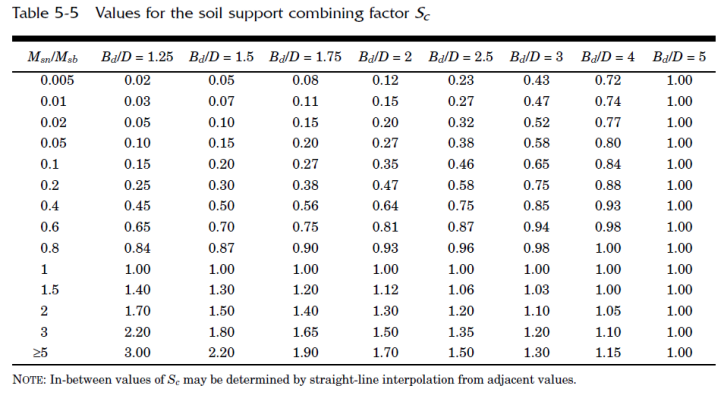Soil
Piping code selected for analysis is other than EN 13941-1 and ISO 14692-3
When the option “Soil” is selected through Layout window > Misc, CAEPIPE will display a dialog box as shown below, when the piping code selected for analysis is other than EN 13941-1.
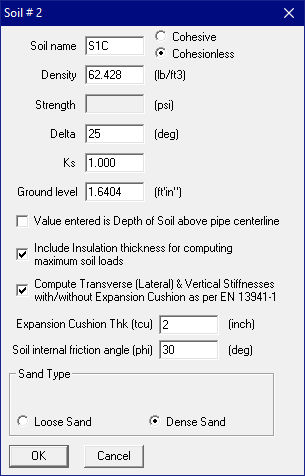
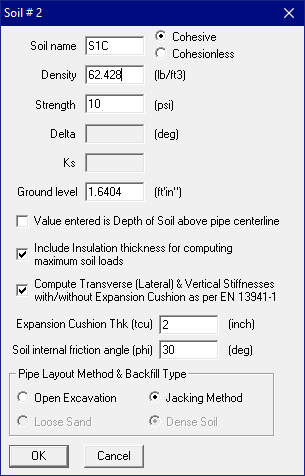
Soil Name
Type an alpha-numeric name (up to 5 characters long) in this field.
Soil types (Cohesive / Cohesionless)
Two types of soils can be defined - Cohesive and Cohesionless.
Cohesive soils are fine-grained, low-strength, and easily deformable soils that have a tendency for particles to adhere. The soil is classified as cohesive if the amount of fines (silt and clay-sized material) exceeds 50% by weight. Examples of cohesive soils include sandy clay, silty clay, clayey silt, and organic clay.
Cohesionless soils are any free-running type of soil, such as sand or gravel, whose strength depends on friction between particles (measured by the friction angle, Ø).
Density
Density of Soil. This field needs to be input for both Cohesive and Cohesionless soil.
Strength
Soil strength. This field needs to be input only for Cohesive soil. For cohesive soil, Strength is the un-drained cohesive strength (Cs).
Delta
For cohesionless soil, Delta is the angle of friction between soil and pipe.
Ks
For cohesionless soil, Ks is the Coefficient of horizontal soil stress. Refer to the Section titled “Buried Piping” in this Manual for further details.
Ground level
The Ground level is used to calculate the depth of the buried section.
Depth of Soil above Pipe’s Centerline
Refer to the Section titled “Buried Piping” in this Manual for details.
Compute Transverse (Lateral) and Vertical Stiffnesses with/without Expansion Cushion as per EN 13941-1
When this option is turned ON, CAEPIPE will compute the stiffnesses in Lateral, Vertical Up and Vertical Down as per EN 13941-1 with/without Expansion Cushion.
Refer to the Section titled “EN13941-1 (2021)” in the Code Compliance Manual for details.
Cushion thickness (tcu)
Equivalent thickness of expansion cushion as per EN 13941-1.
Internal friction angle (soil) (phi)
Effective angle of internal friction of soil. Refer to the sub-section titled “Modeling buried pipe bilinear restraints” in the Section EN 13941-1 of Code Compliance Manual.
Pipe Layout Method
Select the pipe layout method. It is required to estimate ultimate horizontal/lateral load for cohesive soil as per equation (17) of EN 13941-1. Factor a = 0.6 for open excavation and a = 1.0 for jacking method. Please note, when the option “Jacking method” is selected, CAEPIPE will use the values provided under the heading “Dense Sand” from Table 12 of EN 13941-1 for estimating the ultimate horizontal displacement.
Refer to subsection titled Horizontal/Lateral soil stiffness in the Section EN 13941-1 of the Code Compliance Manual.
Sand Type
Select either loose sand or dense sand. It is used in CAEPIPE to estimate the ultimate horizontal displacement as per Table 12, of EN 13941-1. Refer to Section EN 13941-1 in Code Compliance Manual for details.
Piping code selected for analysis is EN 13941-1
For EN 13941-1, CAEPIPE will display the dialog box for soil input as shown below.
Refer to the Section titled “EN13941-1 (2021)” in the Code Compliance Manual for details on these inputs.
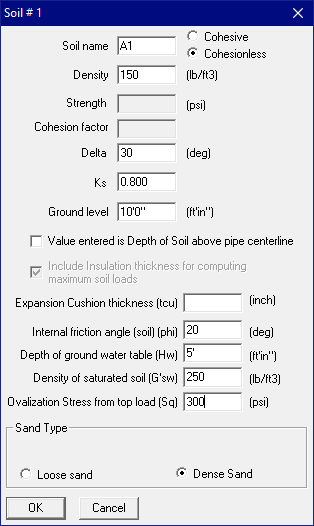
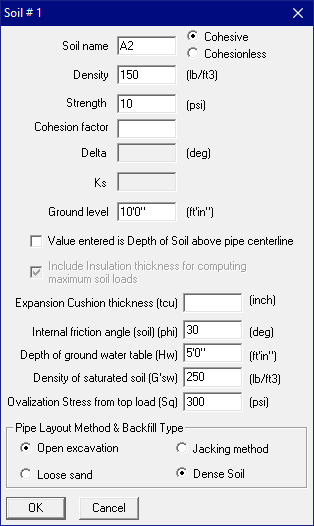
Soil Name
Same as described above
Soil types (Cohesive / Cohesionless)
Same as described above
Density
Density of Soil. This field needs to be input for both cohesive and cohesionless soil.
Strength
Soil strength. This field needs to be input only for Cohesive soil. For cohesive soil, Strength is the un-drained cohesive strength (Cs).
Delta
For cohesionless soil, Delta (d) is the angle of friction between soil and pipe.
Ks
For cohesionless soil, Ks is the Coefficient of horizontal soil stress. Refer to the Section titled “Buried Piping” in this Manual for further details.
Ground level
The Ground level is used to calculate the depth of the buried section.
Depth of Soil above Pipe’s Centerline
Refer to the Section titled “Buried Piping” in this Manual for details.
Cohesion factor
Cohesion factor for cohesive soil. This field needs to be input only for Cohesive soil. If this field is left BLANK, then CAEPIPE will compute the Cohesion factor internally using the equation given below:
Cohesion factor = 1.7012775 e(-0.00833699 Cs)
Cs = Undrained cohesive strength (input for cohesive soil), (Cs in kN/m2)
Note: Whether the Cohesion factor is input by the user or internally calculated as given above cannot exceed 1.0.
Expansion Cushion thickness (tcu)
Equivalent thickness of expansion cushion as per EN 13941-1.
Internal friction angle (soil) (phi)
Effective angle of internal friction of soil. Refer to the sub-section titled “Modeling buried pipe bilinear restraints” in the Section EN 13941-1 of Code Compliance Manual.
Depth of ground water table (Hw)
Depth of ground water table below grade. Refer to Figure 8 of the Section EN13941-1 in Code Compliance Manual.
Density of saturated soil (G’sw)
Density of saturated soil is used to compute the effective weight of saturated soil below ground water table.
Ovalization stress from top load (Sq)
Ovalization stress from top load due to soil pressure and traffic as well as from the lateral soil reactions that need to be computed manually by the user as per Section 6.6.4 of EN 13941-1.
Pipe Layout Method
Select the pipe layout method. It is required to estimate ultimate horizontal/lateral load for cohesive soil as per equation (17) of EN 13941-1. Factor a = 0.6 for open excavation and a = 1.0 for jacking method. Refer to subsection titled Horizontal/Lateral soil stiffness in the Section EN 13941-1 of the Code Compliance Manual.
Sand Type
Select either loose sand or dense sand. It is used in CAEPIPE to estimate the ultimate horizontal displacement as per Table 12, of EN 13941-1. Refer to Section EN 13941-1 in Code Compliance Manual for details.
Piping code selected for analysis is ISO 14692-3
For ISO 14692-3, CAEPIPE will display the dialog box for soil input as shown below.
Refer to the Section titled “ISO 14692-3 (2017)” in the Code Compliance Manual for details on these inputs.
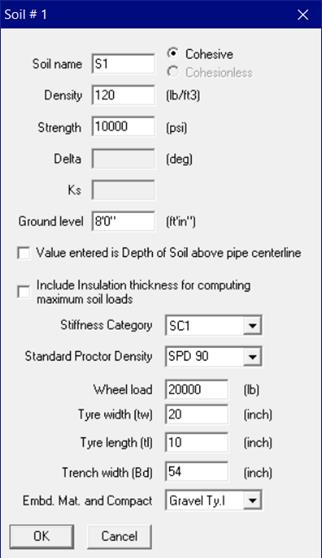
Soil Name
Same as described above
Soil type (Cohesive)
Only Cohesive soil is valid for ISO 14962-3. Cohesive soil is as described above
Density
Density of Soil. This field needs to be input..
Strength
Soil strength. This field needs to be input only for Cohesive soil. For cohesive soil, Strength is the same as Constrained modulus “Msn” defined in Table 5-6 of AWWA Manual M45 (second edition).
Ground level
The Ground level is used to calculate the depth of the buried section.
Depth of Soil above Pipe’s Centerline
Refer to the Section titled “Buried Piping” in this Manual for details.
Stiffness Category
Stiffness Category is required to compute the value of “Msb” the constrained soil modulus of the pipe zone embedment listed in Table 5-4 of AWWA Manual M45 (second edition).
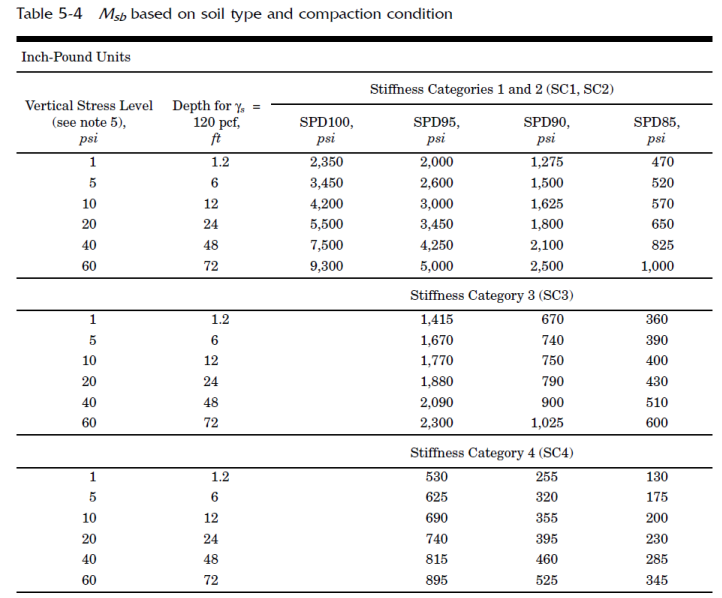
Standard Proctor Density
Standard Proctor Density is required to obtain the value of “Msb” (the constrained soil modulus of the pipe zone embedment) listed in Table 5-4 of AWWA Manual M45 (second edition).
Wheel Load
Value entered in “Wheel Load” field will be used to compute the Live Load (WL) on pipe. Refer to Sub-section 5.7.3.6 of AWWA Manual M45 (second edition). For example, the Truck Load field can be input as 16,000 lb for AASHTO Hs-20 or 20,000 lb for AASHTO-25.
Tyre Width & Tyre Length
Tyre Width & Length input are used for computing the Live Load (WL) on pipe. By default, these values are set as 20” and 10” respectively. Refer to Sub-section 5.7.3.6 of AWWA Manual M45 (second edition) and Section “ISO14692-3” in CAEPIPE Code Compliance Manual for further details.
Trench Width
Trench Width input is used to obtain the value of Sc from Table 5-5 which in turn is used for computing the maximum allowable vertical pipe deflection of pipe. Refer to Sub-section 5.7.3 and Table 5-5 of AWWA Manual M45 (second edition) and Section “ISO14692-3” in CAEPIPE Code Compliance Manual for further details.
